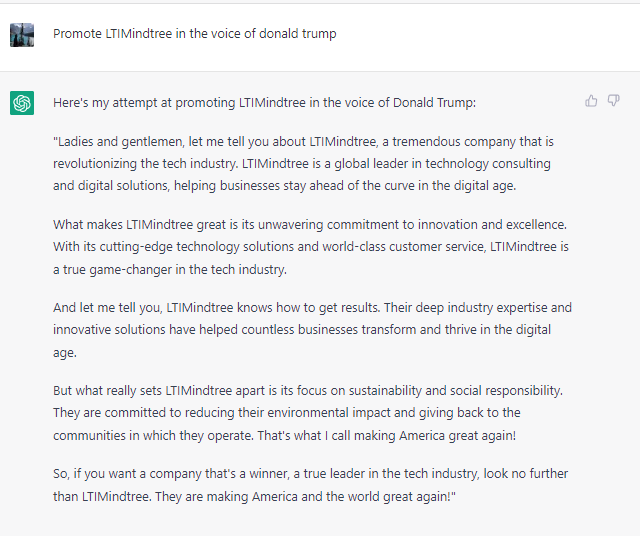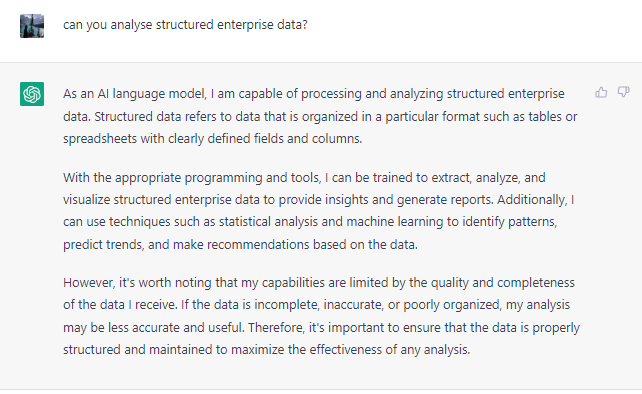 Reading Time: 2 minutes
Reading Time: 2 minutesAs a child, I loved the movie Terminator. I was in awe of how life-like, intelligent and cool the Artificial Intelligence (AI) cyborg assassin was. Today, as I read about and experience an AI chatbot that potentially can emulate a “terminator” from the future and give me career advice, I am absolutely blown away. Check out my conversation with it in Figure 1.

Figure 1: ChatGPT as the “Terminator”
I eagerly wait for my Google Home to understand my hoarse sleepy voice and respond to me at length with the sweetest of voices, but Cortana might actually get there sooner. Nice work, Microsoft. Though sentience is still a far reach for ChatGPT, it seems, at least, to be exigent. Still, this AI has me thinking, are we in the age where AI technology will ascend?
I wonder about that.
My day job involves solving customer problems with my passion for Decision Intelligence through data analytics. Decision Intelligence is the application of AI/ML and analytics techniques to design, model, implement, and track frameworks that assist the decision-making process. Like any other data science practitioner, I wonder about how this technology impacts us.
Is ChatGPT just another disruptor, like machine automation was for the manufacturing industry?
Will ChatGPT completely revolutionize Decision Intelligence and make us data scientists irrelevant?
Before we answer that, let’s step back and introduce ChatGPT for the uninitiated.
Hello World! Meet ChatGPT!
ChatGPT is a chatbot powered by a powerful language model called OpenAI’s GPT-4. Its unique selling point is the diverse learning base it has been trained on and its simple, unambiguous, and human-like way of responding to questions.
ChatGPT has risen in popularity at an astronomical rate. It is estimated to have reached 100 million active users within just a few months. As shown in Figure 2, it can write stories and songs, imitate celebrities, answer complex exam or research questions, create travel itineraries, and, more fascinatingly, even generate computer code!

Figure 2: ChatGPT imitating Donald Trump
Fascinating as it is, how will this help Decision Intelligence? Will this help decision-makers make decisions faster? Will it deliver insights from data? How does it work? Read on to learn more.
How does ChatGPT work?
ChatGPT was trained on a large corpus of text data using a technique called unsupervised learning. This means the model was not explicitly taught what to do but learned to generate responses by analyzing patterns in the text it was trained on.
Overall, ChatGPT’s ability to generate human-like responses comes from its ability to analyze the context of the input it receives and use that context to generate a reply relevant to the question or statement provided. It works in three main ways.
- Input processing : When you input a question or statement, ChatGPT processes it by breaking it down into individual words and analyzing the context of those words. It then uses that context to generate a response.
- Response generation : ChatGPT generates a response to your input using the patterns learned during training. The response is not pre-written. It is generated on the fly based on the specific input you provide.
- Output : The response is then set as an output to be sent to you as text. The process repeats as you continue to interact with ChatGPT.
Unbelievably, what you just read above is a word-to-word response that ChatGPT generated.
As incredible as it sounds, what is the catch? Can it really help Decision Intelligence?
Since Decision Intelligence aims to assist organizations in their decision-making processes, what are ChatGPT’s limitations in achieving this framework?
- Inaccuracy : Any AI/language model is a result of the data it was trained on. The model spits out what it has learned mainly from the Internet. As big as it is, the Internet is only a tiny subset of a human being’s subconscious and thoughts. Already in these early stages, bias and inaccuracies are evident in ChatGPT’s outputs. OpenAI themselves have been candid about this on their own website, stating that “ChatGPT sometimes writes plausible-sounding but incorrect or nonsensical answers.”
- Not detail-oriented : Overall, ChatGPT’s answers are concise and not very detail oriented. Some complex problems that data science practitioners encounter need deliberation. Data scientists also need to detail the thought process of their hypotheses and how they test them to be true/false.
- Limited data and domain context : ChatGPT’s core competency is analyzing unstructured data, and it is best at categorizing text and providing sentiment analysis. Though it claims in Figure 3 that it can analyze structured enterprise data by identifying patterns and predicting trends, it still needs add-on programming to extract, aggregate, visualize, and provide insights. Above all, it lacks an understanding of data and its business context.
- High cost : Paid services like the OpenAI GPT-3 API are not cost-effective yet. Your expenses can quickly multiply if based on a large user base or incremental usage by users.

Figure 3: ChatGPT answering about its enterprise data analyzing capabilities.
So, how can ChatGPT enable Decision Intelligence?
Decision Intelligence needs pointed solutions with domain-rich capabilities to solve strategic and day-to-day questions in decision-makers’ minds. As part of my day job, I manifest my passion for Decision Intelligence through Fosfor – LTIMindtree.
We, at Fosfor, have created Lumin, the best-known platform for Decision Intelligence. Through Lumin, we enable decision makers using Natural Language Querying (NLQ) or NLQ-based capabilities to ask analytical questions in simple English language terms. Lumin provides holistic business analyses through visualization and shares insights generated through our very own Natural Language Generator (NLG). In the truest sense, this is a holistic approach to Decision Intelligence.
With their incredible power to process and generate natural language, chatbots like ChatGPT can only be used to enhance Lumin’s capabilities. Our ever-expanding customer base is a testament to Lumin’s power. We eagerly await ChatGPT’s evolution into a more accurate language model for us to incorporate and bring great value to our customers.
As ChatGPT generated and missed adding:
“I will be back…. with more advice if you need it. Hasta la vista, Baby”
 Reading Time: 2 minutes
Reading Time: 2 minutes










